Daredevil Preview
We get spend some time with the developers of Encore's upcoming Daredevil game. Read all about it.
In the past, comic books have been the source material for a number of characters and stories that have been translated into the video game medium. From Men in Black and Blade to Batman and Superman, comic books have inspired a number of developers to bring stories told through still imagery to a medium that offers immediate gratification and visuals that can't quite be captured as vividly by ink on paper. The latest comic property to be brought to virtual life is Marvel Comics' Daredevil.
Daredevil, the man without fear, was originally created by Bill Everett and Stan Lee in 1964, and it has since been interpreted by such comic notables as Wally Wood, Gene Colan, Frank Miller, Kevin Smith, and Brian Michael Bendis. Like so many comic heroes, Daredevil's origin is steeped in tragedy. As a young boy, Matt Murdock was struck across the eyes and blinded by a radioactive isotope while trying to save an old man's life during a freak accident. Fortunately, the isotope mutated his nerve centers and amplified his remaining senses to superhuman levels, allowing him to taste, smell, and hear better than anyone else. Through training with a mysterious benefactor known as Stick, he also developed a radar sense that provides him with a superhuman awareness of his surroundings at all times. Years later, the death of his father at the hands of a mob of gangsters compelled Matt Murdock to battle injustice. By day, he serves as a renowned defense attorney. By night, he patrols the rooftops of New York City's Hell's Kitchen as Daredevil, working to punish evil in ways that the law won't allow.
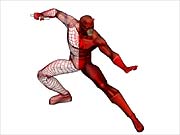
The first details released on the Daredevil game, which is being developed by 5000ft and will be published by Encore, covered the custom adaptation of the comic book continuity to form the background of the video game's unique plot. The game's story, which draws inspiration from a number of notable story arcs from the comic book, revolves around Daredevil's mission to rescue his best friend and law partner, Foggy Nelson, who has apparently been kidnapped by a mysterious party. To make matters worse, the Kingpin of Crime has been murdered, causing the worst gang war in New York's history. Best of all, Daredevil has discovered that his former college love, Elektra, is currently in New York and is in some way connected with the Kingpin's murder. Daredevil's concern for his friend's safety, the gangs' threat to the city, the Kingpin's murder, and the mystery behind Elektra reappearance in New York set the stage for a multifaceted plot that should have more than a twist or two.
From what we gathered, the game will put you in Daredevil's tights as you try to find Foggy and Elektra on the dark streets of seedy Hell's Kitchen, all the while avoiding Yakuza punks, Mafia thugs, and The Hand's cadre of ninjas. The game's scenery is directly inspired by the work of some of comics' most popular artists and re-creates oft-visited locales in Hell's Kitchen, while the Daredevil character will be able to maneuver through the city with ease, thanks to his acrobatics and his signature billy-club-and-grappling-hook combination. Many of the blind superhero's signature techniques from the comic will be included in his set of in-game abilities. As a result, Daredevil should have a wide array of armed and unarmed attacks, swinging maneuvers, and other moves that set him apart from other adventure game characters.
While the game is still in the early stages of development, we were able to sit in on one of its motion-capture sessions and check out what's going on firsthand. Daredevil is being portrayed, at least in wireframe form, by Reuben Landon, the same stuntman/actor who helped animate Jedi Knight II: Jedi Outcast and Soldier of Fortune II. In addition to Daredevil, Landon's motions will also be taped for Bullseye and assorted Yakuza characters.
During the session, we had the opportunity to chat with some members of the development team. First up was art director and artist Joey Elardy of developer 5000ft. We got the first details on his experiences working on the Daredevil license, what the game will look and feel like, what strides have been made in the game's development, and what players can expect from the game when it hits stores.
GameSpot: What is it like working on the Daredevil game?
Joey Elardy: It's funny--when I was a little kid, I used to trace over Daredevil comics to learn how to draw, so this is like a dream for me! I've been reading the comics since I was a kid. The guys who have worked on Daredevil in the past--Wally Wood, Gene Colan, Frank Miller, John Romita--they're all brilliant.
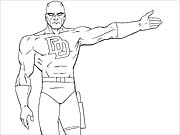
GS: So who's the biggest influence on your style of Daredevil?
JE: For this game, it would be a combination of Joe Quesada and Frank Miller. I'm trying to combine their strengths. The stuff that Brian Smith and Quesada did was absolutely brilliant, the stuff that David Mack and Quesada did was fantastic, and we're trying to get a little bit of that in there. And, of course, the Frank Miller story arc--it's just brilliant, so why not use it?
GS: How did you work with past Daredevil story arcs to come up with a story for the game?
JE: Obviously, storywise, when cowriter John Daud and I were coming up with the story, we couldn't follow the same kinds of conventions used in comics or books, because of the nature of games. So, we were trying to write it in such a way that you wouldn't have to watch a bunch of cinematics to understand it, because we felt that, with Daredevil, people would want to play and not watch. So we really tried to weave as much of the great story elements into the game as we possibly could. So we were always thinking, "OK, that's a good story element, but how are we going to tell it through gameplay, rather than through a cinematic?" For me personally, and I feel this goes for all of us, we prefer playing! So we try and infuse that as much as possible into the game. But so far, it's been a blast, as you could probably imagine!
GS: The Daredevil comics always had a strong atmosphere. What sorts of environments will we be able to explore as Daredevil?
JE: I have to keep a lot of this under wraps, but you can expect to find Hell's Kitchen and the usual environments you would find in Daredevil comics, as well as a couple of new ones that we're throwing in for story reasons. What I can say is that we're trying to come up with a unique visual style. We've been looking at various games for inspiration, as far as visual style goes, but we're definitely trying to end up with something that's unique, and that's something that we've been focusing on since the very beginning.
GS: Does the art team have a background in comics?
JE: I don't personally. It was something I always loved, but I was never really fast. Unless you're very fast and very tight, it's hard to make a living at it. I was kind of spoiled since I started with 2D animation and learned 3D really quickly. One of our artists does have a sequential art background, having worked as a board artist on X-Men: Evolution and Spider-Man: Unlimited.
GS: Have you found it difficult translating the still 2D images of comic books into moving 3D images?
JE: Absolutely. One of the big things is that people first started telling us is, "Oh, we want to get this comic book look," but in 3D, it's actually easier to achieve a photo-realistic look, because you can actually use photographs as a base. Trying to achieve a comic book look takes a lot of research, and getting it to look right is difficult, because a lot of the things we experimented with just didn't work. One request was to "make the textures more like a comic, put crosshatching in the textures." But when you do that, it doesn't look like shading, it looks like someone took a giant paintbrush and painted onto 3D. So it's very hard achieving a comic book look and making it look convincing--and I'm not talking about an animated look, like a cel-animated look, I'm talking about a comic book look. Because there's a big difference there, There are cel-shaders we could use, but that's definitely not the look we're going for.
We wanted to stay in the film-noirish, Miller-esque, and Quesada-esque dark look. We've been trying to push the technology to get those kinds of lighting effects. It's something the programmers hate us for because we absolutely have to have these kinds of lighting effects and dynamic shadows, and it makes them pull their hair out because from a programming standpoint it's a bit more difficult. But it's definitely a challenge.
GS: What other challenges have you come across?
JE: I've been buying Daredevil comics since I was a kid, and this is a very, very personal thing to me. I have some very vivid ideas of what I'd like to see in the game. So if I had 10 years or an unlimited amount of time to make a game, I could make it perfect, but I have certain constraints I have to fall into. So the challenge is to take as much of what I want as I can and make the best game possible.
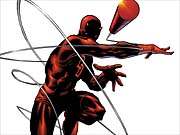
The biggest difficulty on any project is time, and while you can achieve any look you want with enough time, the trick is to find a way to do it within the time constraints. That's the real challenge.
GS: How much of an effect has the upcoming movie had on the video game?
JE: I've had the opportunity to see a bunch of stuff from the movie and see what they are doing. It was a definite influence on us, but what we're shooting for is to be unique. Fans of the comic book should be pleased.
GS: Considering the other superhero games that have been released in the past, what new experiences are you trying to bring players with Daredevil?
JE: The main thing that we're trying to bring to players with Daredevil is that if there's a way to relay this character's depth through gameplay, and tell his story through gameplay, then we can provide a unique experience to all the people out there in the same way that the movie and the comics provide their own unique experiences. And following in the tradition of people like Wally Wood, Gene Colan, Frank Miller, and Joe Quesada, we've tried to bring the same dark, hard-boiled pulp feel that has always been attributed to Daredevil. We have a tremendous amount of respect for the character and the creators behind it, and we want to be able to show this game to people like Frank Miller and Joe Quesada and have them say, "Wow, this is really cool!" And we have this big fear in the back of our heads of walking down the street, getting pelted by tomatoes, and hearing the fans cry, "How could you do that to Daredevil?" That's something that we're always going to be conscious of. Because, in the end, we have a great amount of respect for the character, and we really want to translate that into video games without losing anything that people love about him.
GS: Thanks for your time.
After our meeting with Joey Elardy, we got together with Encore senior producer Eric DeMilt to get his impressions on working with Daredevil, what he wants out of the game, and what players should look forward to.
GameSpot: Can you give us a bit of background on the experience you've had working with Daredevil and what it's been like working on the project?
Eric DeMilt: It's been really cool. Working at a publisher you look at a lot of brands and do a lot of market analysis, but I read comic books a lot when I was in high school, so it's been good to be a part of this particular process. When we decided to do a game based on a comic book character, we looked at all of them out there and looked at what was available, because a lot of the big ones have recently been taken. So when we were looking at the options, I kept looking at Daredevil and weighing in all these different factors, like who's got a movie coming up. Being a huge Daredevil fan, I was part of that decision. And now we get the chance to make the Daredevil game and decide what we're going to do with it. It's kind of huge.
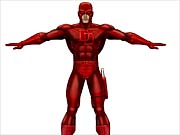
Going through that first process, and then finding the 5000ft guys was great, because they're such huge fans. Joey is so excited, we could probably slash the budget and he'd still do the project and put in all the extra time and energy. Working with Daredevil is great--just having a character that people just get and dig, it's like writing a story or a game on something that everybody can get into. So then you have all these ideas, and you have to figure out how to capture them. Because there are all these great scenes in the comic books, and Daredevil doesn't have to adhere to the laws of physics, because he's just constantly flying through the air and looking good, and you have to find a way to just be Daredevil. It has to be just as fun to get around as it is to fight. The story part is relatively easy, because coming from the comic book, the story comes prepackaged with built-in villains. Every good hero has a good villain, and vice-versa, so here you've got Bullseye and the Kingpin. Elektra is a little more difficult, because here you have an antihero, with something like a Batman-Catwoman relationship that will be hard to get across in a video game. "I love her! Wait, she stabbed me!" How do you keep the player from just punching her in the head? "She's annoying, she keeps stabbing me!" That particular aspect was a little tougher, but it's cool to be able to work with these things.
GS: What is it like working with Marvel Comics?
ED: It's great being able to work with Marvel Comics. I used to go to comic conventions as a kid, like the San Diego Comicon. Now, I can call them up and ask if I can have Joe Quesada work on something for me. And they say, "Sure, as long as you pay him and he's got time." So being able to work with someone like the editor-in-chief guy at Marvel is really cool, too.
GS: What do you think of other comic book games from the past? How have they influenced Daredevil?
ED: There's the pre-3D stuff, like the Batman side-scrollers and Capcom's Marvel Super Heroes fighting game, and a lot of cool things like side-scrolling Superman flying along, and those were either good or bad based on whether or not they captured the look of the characters and introduced new gameplay mechanics. But the game that I see as the defining superhero game is Neversoft's original Spider-Man. I mean, that was it, you were the guy! It was fun, and the look was there. One thing I didn't enjoy is that Daredevil was in that game, but he was just kind of walking by and saying, "Hey, Spidey, how ya doin'?" and you didn't get to interact with him. So that was a bummer. But Spider-Man was definitely the "you are the superhero" benchmark.
One big non-comic book influence is Grand Theft Auto III, "the living city." Daredevil is in Hell's Kitchen, so how much of GTAIII is applicable? What do we do? Daredevil doesn't go around beating people up, but that's what game players do! They think of it like a flight sim, except they strafe women and children. We had to balance the amount of freedom players have with what the character is all about.
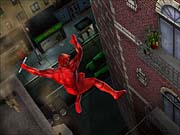
GS: So what makes up the Daredevil character, from a gameplay perspective?
ED: With Daredevil, you also don't want to make Spider-Man with horns, or Batman without a car, because that would be the easy thing to make. "Sure, he doesn't have all the gizmos, but he's Batman, really." So we have to consider how to take advantage of the fact that he has heightened senses, but that's an abstract concept. He has more senses than anybody else, but you're seeing his world through a TV screen with a limited field of view and gameplay considerations. And how do we make it so that it's not like we have to put on a pair of funky X-ray glasses? So we're trying to work all this together, but using elements from those other games that have established the look and feel of being a character in a living city.
You want to be able to "be" Daredevil, this vigilante with a dark personality in this unique, gritty world. And you have to consider getting all that to come together without being awkward for the player. There's some danger of getting caught up with the fanboy mentality of, "He's Daredevil! Daredevil wouldn't do that!" So he wouldn't just punch Elektra, but then you have to consider what would be fun, so you have to either avoid those situations, or err on the side of fun gameplay.
GS: What can players expect when they pick up a controller and play as Daredevil?
ED: A 3D character-based action adventure game is what it really is, and it has to be fast-paced. It has to match my play style, and I don't have a lot of patience. I never watch most of the movies in games, and it reminds me of when I was working on Fallout and Fallout 2. There were three ways to play the game: you could talk your way through any problem, sneak your way through any problem, or take the Eric approach, which was to shoot everybody and pick up the pieces. "What information did I need?" And the designers would seriously put in extra bits of information just in case players like me accidentally shot the guy you were supposed to talk to, so you couldn't just kill the game.
So we want to make it fast-paced and a lot of fun. While we will expose the character's origin to players, we want to make it so that if someone buys Daredevil because they see this tough guy on the box, we want them to be able get in there and fight, not having to save an old guy crossing the street. We're conscious of staying true to the character, but also of what people are going to want to do with him.
We want the movement to be a lot like a Sonic the Hedgehog game. Daredevil doesn't just walk, and the levels aren't flat. His environments are dimensional and tiered, because he's running and jumping from rooftop to rooftop and landing on ledges and flagpoles and zipping across telephone wires, all in this great Hell's Kitchen look. So when you pick it up, it'll feel like a really tough Sonic the Hedgehog, where you run around at this constant fast pace, and since he's such a tough character, you put him in situations with heroic fight scenes, because he's a brawler. And then you find a way to fit in his heightened senses, and have it be cool without making it a distraction, because entering "heightened sense mode" where you have to touch everything in a hunt-and-peck fit would be a disaster. So basically, players can relate Daredevil to an angry, tough Sonic.
GS: So, will the storyline be an adaptation of the upcoming movie's story, or an adaptation of the storylines in the comic books?
ED: The nice thing is that from what we know of the movie script, it stays fairly close to the character. They're obviously going to have their own interpretation of what the Kingpin's office high-rise looks like, what the Kingpin looks like, and what Daredevil looks like, but Daredevil is not trying to be The Postman, so it's not radically different from the spirit of the story. And we want to stick to the comic and the comic's look. If you look at the history of Daredevil comics, writers and artists come off and on, with different takes on the same character, and I'm sure we'll have our own interpretation of the character, because of considerations due to the medium we're working in. But it's not Daredevil: The Movie game, specifically, and it's our own story, but the Kingpin's in it, Bullseye's in it, and we're not going to make Bullseye a misguided good guy, because he was an abused child and we have to help him. He's a bad guy, he's a psycho, and so those sorts of things will be true to form.
GS: Considering that Daredevil is a relatively unknown Marvel Comics character in the mainstream, what are you going to do to draw in the casual game player who isn't familiar with the character?
ED: I think that Daredevil almost is what the first Spider-Man game was. And Daredevil is the archetypal hero--he's Han Solo in red tights, he's Indiana Jones, he's Spider-Man. Tall buff guy, square chin, Ben Affleck, there he is! So whenever people see Daredevil on the cover of a box or in an ad, they're going to recognize him on a basic level, so he's mainstream. And, of course, with the movie launch, Ben Affleck and Jennifer Garner are going to be doing their press thing, so a lot of people out there besides dorks like me (not to insult dorks) will have heard of Daredevil and will be able to connect to him. And other companies will surely have continued success with their Marvel character games, so it's all becoming more mainstream.
GS: So will Daredevil be for all audiences?
ED: We're shooting for a Teen rating with Daredevil. It's not going to be a Grand Theft Auto III-style Mature-rated game, but we also want to show that he's a tough character and illustrate the physicality of his personality. By nature, Daredevil is for teen audiences because of what he does--he punches people, he beats up criminals. Violence is rewarded, in so much that you beat up the guy trying to rape someone. Still, it's all fantasy, like a book. I've read Daredevil comics for years, and rarely have I put on tights and fought crime. We want Elektra to be attractive, and make a sexy video game character, but that doesn't mean we'll pander to low-brow content like "Ooh, boobies."
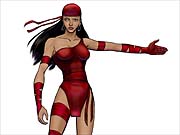
GS: How far along is the game's development?
ED: We're about a month away from a playable prototype, and that's really the point at which we can measure what we've got. We want to get an area, maybe five or six rooftops, and just try and have fun with it. We have to find out what's fun about it and discover if it's fun to just run around with the character. Then we take that and expand on it. We'll definitely be there by E3, where we'll be showing the game.
GS: We look forward to checking it out. Thanks for your time, Eric.
Check out some artwork and early media from the Daredevil game, and stay tuned for more on Daredevil as it we follow its development and play it at the upcoming Electronic Entertainment Expo.
Got a news tip or want to contact us directly? Email news@gamespot.com
Join the conversation